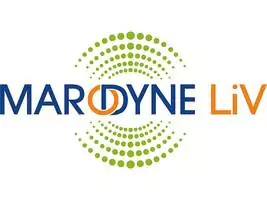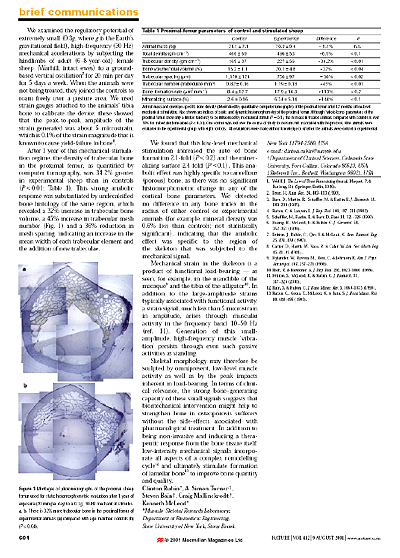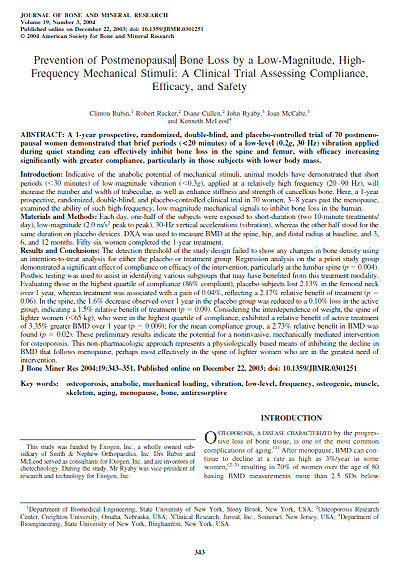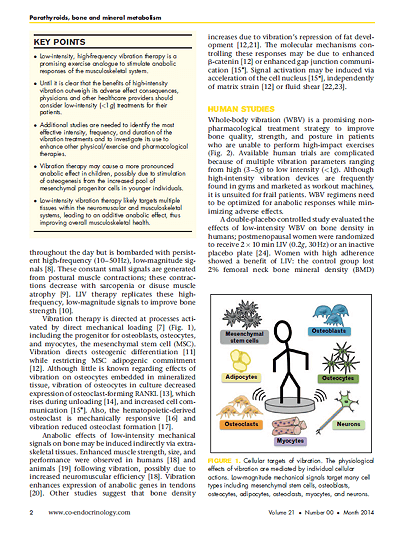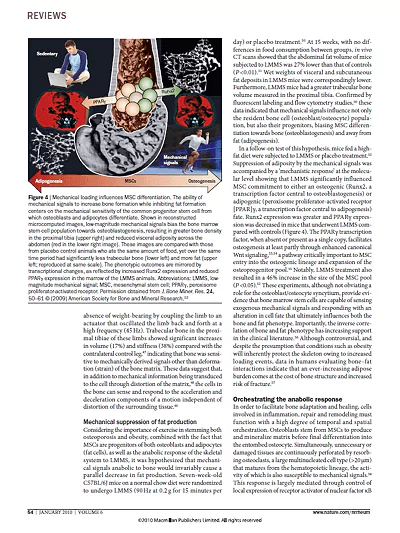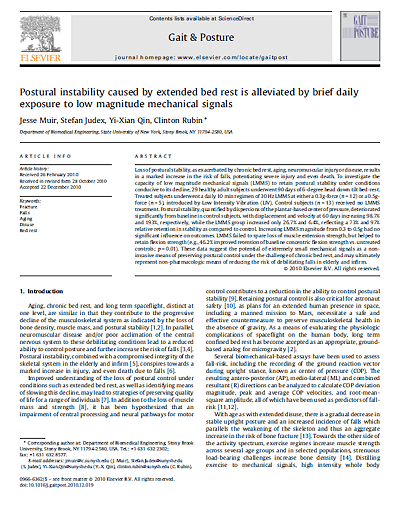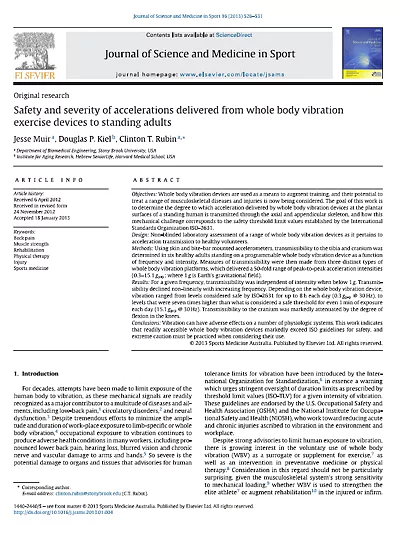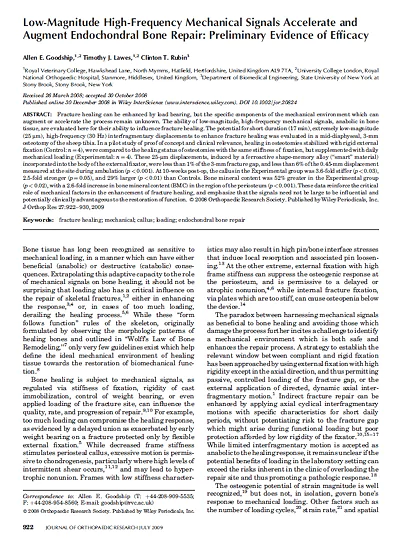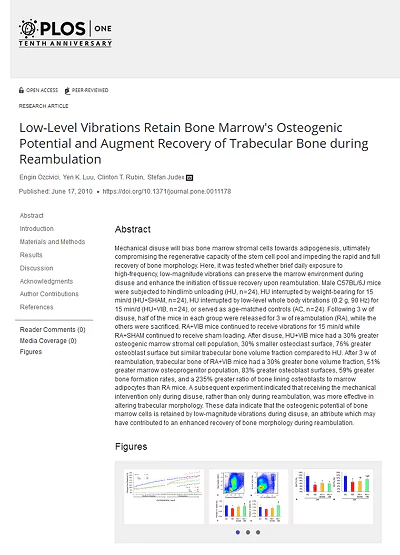Vibrationstraining LiV: Studien und Literatur
Wissenschaftliche Artikel und interdisziplinäre Studien
Unter Studien verstehen wir medizinisch-wissenschaftliche Veröffentlichungen, zumeist von Wissenschaftlern für Wissenschaftler gedacht - und daher für Laien oft schwer zu verstehen. Die Studien sind auch in führenden wissenschaftlichen Zeitschriften veröffentlich worden - die Therapie mit LiV wird in der medizinisch-wissenschaftlichen Fachwelt detailliert beschrieben. Dies entspricht unserem Grundsatz: Überzeugung durch wissenschaftliche Fundamente, EBM 'evidenced based medicine' als Standard einer modernen Behandlung.
Mehr als 100 wissenschaftliche Artikel sowie » interdisziplinäre Studien auf der biochemischen, molekularen und zellulären Ebene, mehr als 30 in peer-reviewed-Zeitschriften veröffentlicht, einschließlich mehrere Placebo-kontrollierte Doppelblindstudien, zeigen, dass die Therapie Muskelaufbau und bessere Knochenqualität unterstützt. Im Folgenden einige wichtige Beiträge und Studien, gerne bieten wir Ihnen hierzu auf Wunsch weitere Informationen.
Zertifiziertes Medizinprodukt

Marodyne LiV verfügt über eine Zulassung als Medizinprodukt Klasse IIa (gem. Richtlinie 93/42/EWG), erstellt von der BSI British Standards Institution, dem internationalen Marktführer für Zertifizierungen. Hierzu erfolgen im Rahmen der klinischen Prüfung systematische Untersuchungen, die Sicherheit oder Leistung eines Produkts beschreiben. Hersteller müssen belegen, dass ihre Produkte sicher sind und den versprochenen Nutzen bringen.
1. K. S. Leung et al.: Effects of 18-month low-magnitude high-frequency vibration on fall rate and fracture risks in 710 community elderly - a cluster-randomized controlled trial, Osteoporosis Int. 2014 Jun;25(6):1785-95
2. Rubin C, Recker R, Cullen D, Ryaby J, McCabe J, McLeod K.: Prevention of postmenopausal bone loss by a low-magnitude, high-frequency mechanical stimuli... JBMR 2004 Mar, 19(3):343-351
3. Mogil RJ, Ness KK.et al.: Effect of Low-Magnitude, High-Frequency Mechanical Stimulation on BMD Among Young Childhood Cancer Survivors: A Randomized Clinical Trial. JAMA Oncol. 2016 Jul 1;2(7):908-14. doi: 10.1001/jamaoncol.2015.6557
4, Jesse Muir, Douglas Kiel, Clinton Rubin: Safety and severity of accelerations delivered from whole body vibration exercise devices to standing adults, J Sci Med Sport. 2013 Nov;16(6):526-31
5. Engin Ozcivici, Janet Rubin, Stefan Judex, Clinton T. Rubin et al.: Mechanical signals as anabolic agents in bone. Nature Reviews Rheumatology 6, 50-59, 2009 (January 2010)
6. Clinton Rubin, A. Simon Turner, Steven Bain, Craig Mallinckrodt, Kenneth McLeod: Anabolism: Low mechanical signals strengthen long bones. Nature, August 2001, Band 412, 603-604
7. Huang RP, Rubin CT, McLeod KJ: Changes in postural muscle dynamics as a function of age. J Gerontol A Biol Sci Med Sci. 1999
8. Rubin CT et al.: Quantity and Quality of Trabecular Bone in the Femur Are Enhanced by a Strongly Anabolic, Noninvasive Mechanical Intervention. J Bone Miner Res. 2002
9. Leung, KS; Cheung, WH et. al: Low-Magnitude, High-Frequency Vibration Enhances Fracture Healing and Rehabilitation in Elderly with Intertrochanteric Fractures, 2011 ORS Annual Meeting. Long Beach, CA, USA. Jan 13-16, 2011. Podium presentation
10. Kiel DP, Hannan MT, Rubin CT et al.: Low-Magnitude Mechanical Stimulation to Improve Bone Density in Persons of Advanced Age. A Randomized, Placebo-Controlled Trial. JBMR 2015 Jul;30(7):1319-28
11. Qin YX, Rubin CT, McLeod KJ: Nonlinear dependence of loading intensity and cycle number in the maintenance of bone mass and morphology. J Orthop Res. 1998 Jul;16(4):482-9
12. Weißbuch Osteoporose, Hrsg.: Berufsverband der Fachärzte für Orthopädie e.V., Berlin, 2004
13. Frankel, Victor: Biomechanical Approach to Osteoporosis, 2005, Vorlesung, Berufsgenossenschaftliche Unfallklinik Murnau, Murnau a. Staffelsee
14. Prof. Dr. Dr. Dieter Gebauer, CA Orthopädische Klinik Tegernsee, Interview 2008, Gmund / Tegernsee
15. Prof. Dr. Wolfgang Kemmler, Dr. Simon von Stengel: Ganzkörper Vibrationstraining, Mobiles Leben, 2015, Heft 3, Kuratorium Knochengesundheit e.V., Sinsheim
16. (2019) Pagnotti, Ness, Rubin, Rubin et al. - Combating osteoporosis and obesity with exercise: leveraging cell mechanosensitivity, Nature. Rev. Endo. 2019
17. (2020) Bas, Woods et al - Low Intensity Vibrations Augment Mesenchymal Stem Cell Proliferation and Differentiation Capacity during in vitro Expansion, Nature, Scientific Reports volume 10, Article number: 9369 (2020)
19. (2020) Rajapakse et al - Effect of Low Intensity Vibration on Bone Strength, Microstructure, and Adiposity in Pre-Osteoporotic Postmenopausal Women: A Randomized Placebo-Controlled Trial
20. (2022) Bianchi et al - Low-Intensity Vibration Protects the Weight-Bearing Skeleton and Suppresses Fracture Incidence in Boys With Duchenne Muscular Dystrophy: A Prospective, Randomized, Double-Blind, Placebo-Controlled Clinical Trial
Marodyne LiV
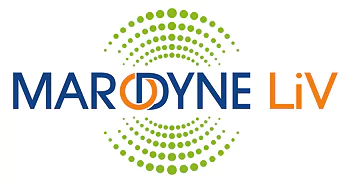
Das Besondere sind die feinen und gleichzeitig aktivierenden Impulse unseres Therapie-Systems. Die Technik zur Erzeugung dieser Impulse ist patentiert und geschützt. Marodyne LiV ist führend und weltweit eines der modernsten, zertifizierten Medizinprodukte für Vibrationstraining, welches Impulse von 0,4 g mit einer Amplitude von ca. 0,1 mm applizieren kann. Diese Impulse bieten ein hohes Maß an Sicherheit und Verträglichkeit.
Prof. Dr. Clinton Rubin

Prof. Dr. Clinton Rubin zum Thema LiV - Vibrationstraining zur Behandlung von Osteoporose, Immobilität und altersbedingter Muskelschwäche (Sarkopenie) » mehr
Anabolism: Low mechanical signals strengthen long bones.
Clinton Rubin, A. Simon Turner, Steven Bain, Craig Mallinckrodt & Kenneth McLeod
[2001 Rubin - Anabolism] Although the skeleton's adaptability to load-bearing has been recognized for over a century, the specific mechanical components responsible for strengthening it have not been identified. Here we show that after mechanically stimulating the hindlimbs of adult sheep on a daily basis for a year with 20-minute bursts of very-low-magnitude, high-frequency vibration, the density of the spongy (trabecular) bone in the proximal femur is significantly increased (by 34.2%) compared to controls. As the strain levels generated by this treatment are three orders of magnitude below those that damage bone tissue, this anabolic, non-invasive stimulus may have potential for treating skeletal conditions such as osteoporosis... » mehr
Prevention of Postmenopausal Bone Loss by a Low-Magnitude, High-Frequency Mechanical Stimuli: A Clinical Trial Assessing Compliance, Efficacy, and Safety.
Clinton Rubin, Robert Recker, Diane Cullen, John Ryaby, Joan McCabe, and Kenneth McLeod
[2004 Rubin - Postmenopausal Bone Loss] A 1-year prospective, randomized, double-blind, and placebo-controlled trial of 70 postmenopausal women demonstrated that brief periods (<20 minutes) of a low-level (0.2g, 30 Hz) vibration applied during quiet standing can effectively inhibit bone loss in the spine and femur, with efficacy increasing significantly with greater compliance, particularly in those subjects with lower body mass. Introduction: Indicative of the anabolic potential of mechanical stimuli, animal models have demonstrated that short periods (<30 minutes) of low-magnitude vibration (<0.3g)... » mehr
Vibration therapy: clinical applications in bone
[2014 J. Rubin - Vibration Therapy] The musculoskeletal system is largely regulated through dynamic physical activity and is compromised by cessation of physical loading. There is a need to recreate the anabolic effects of loading on the musculoskeletal system, especially in frail individuals who cannot exercise. Vibration therapy is designed to be a nonpharmacological analogue of physical activity, with an intention to promote bone and muscle ... » mehr
Mechanical signals as anabolic agents in bone.
Engin Ozcivici, Yen Kim Luu, Ben Adler, Yi-Xian Qin, Janet Rubin, Stefan Judex and Clinton T. Rubin
[2010 Ozcivici - anabolic agents] Aging and a sedentary lifestyle conspire to reduce bone quantity and quality, decrease muscle mass and strength, and undermine postural stability, culminating in an elevated risk of skeletal fracture. Concurrently, a marked reduction in the available bone-marrow-derived population of mesenchymal stem cells (MSCs) jeopardizes the regenerative potential that is critical to recovery from musculoskeletal injury and disease. A potential way to combat the deterioration involves harnessing the sensitivity of bone to mechanical signals, which is crucial in defining, maintaining and recovering ... » mehr
Postural instability caused by extended bed rest is alleviated by brief daily exposure to low magnitude mechanical signals
Jesse Muir, Stefan Judex, Yi-Xian Qin, Clinton Rubin
[2011 Muir - Postural instability] Loss of postural stability, as exacerbated by chronic bed rest, aging, neuromuscular injury or disease, results in a marked increase in the risk of falls, potentiating severe injury and even death. To investigate the capacity of low magnitude mechanical signals (LMMS) to retain postural stability under conditions conducive to its decline... » mehr
Safety and severity of accelerations delivered from whole body vibration exercise devices to standing adults
Jesse Muir, Ph.D., Douglas P. Kiel, M.D., M.P.H, and Clinton T. Rubin, Ph.D.
[2013 Muir - Safety and severity] Whole Body Vibration (WBV) devices are used as a means to augment training, and their potential to treat a range of musculoskeletal diseases and injuries is now being considered. The goal of this work is to determine the degree to which acceleration delivered by WBV devices at the plantar surfaces of a standing human is transmitted through the axial and appendicular skeleton, and how this mechanical challenge corresponds to the safety Threshold Limit Values (TLV) established by the International Standards Organization ISO-2631... » mehr
Low-Magnitude High-Frequency Mechanical Signals Accelerate and Augment Endochondral Bone Repair: Preliminary Evidence of Efficacy.
Allen E. Goodship, Timothy J. Lawes, and Clinton T. Rubin.
[2009 Goodship - Bone repair] Fracture healing can be enhanced by load bearing, but the specific components of the mechanical environment which can augment or accelerate the process remain unknown. The ability of low-magnitude, high-frequency mechanical signals, anabolic in bone tissue, are evaluated here for their ability to influence fracture healing. The potential for short duration (17 min), extremely low-magnitude (25 μm), high-frequency (30 Hz) interfragmentary displacements... » mehr
Low-Level Vibrations Retain Bone Marrow's Osteogenic Potential and Augment Recovery of Trabecular Bone during Reambulation.
Engin Ozcivici, Yen K. Luu, Clinton T. Rubin, Stefan Judex
[2010 Ozcivici - Osteogenic Potential] Mechanical disuse will bias bone marrow stromal cells towards adipogenesis, ultimately compromising the regenerative capacity of the stem cell pool and impeding the rapid and full recovery of bone morphology. Here, it was tested whether brief daily exposure to high-frequency, low-magnitude vibrations can preserve the marrow environment during disuse and enhance the initiation of tissue recovery upon reambulation.... » mehr
Low-Level, High-Frequency Mechanical Signals Enhance Musculoskeletal Development of Young Women With Low BMD.
Vicente Gilsanz, Tishya AL Wren, Monique Sanchez, Frederick Dorey, Stefan Judex, and Clinton Rubin
[2006 Gilsanz - Musculoskeletal Development] The potential for brief periods of low-magnitude, high-frequency mechanical signals to enhance the
Low-Level, High-Frequency Mechanical Signals Enhance Musculoskeletal Development
musculoskeletal system was evaluated in young women with low BMD. Twelve months of this noninvasive signal, induced as whole body vibration for at least 2 minutes each day, increased bone and muscle mass in the axial skeleton and lower extremities compared with controls. Introduction: The incidence of osteoporosis, a disease that manifests in the elderly, may be reduced by increasing peak bone mass in the young. Preliminary data indicate that extremely low-level mechanical signals are anabolic to bone tissue, and their ability to enhance bone and muscle mass... » mehr
Low-Intensity Vibration Protects the Weight-Bearing Skeleton and Suppresses Fracture Incidence in Boys With Duchenne Muscular Dystrophy:
A Prospective, Randomized, Double-Blind, Placebo-Controlled Clinical Trial
Maria Luisa Bianchi, Silvia Vai, Giovanni Baranello, Francesca Broggi, Stefan Judex, Thomas Hangartner and Clinton Rubin
Clinton Rubin: "A major consequence of Duchenne Muscular Dystrophy is poor bone strength, with high susceptibility to fracture. This study shows that patients with Duchenne, who stood on the device for 10 minutes per day over the course of a year, built up bone structure in the lower limbs, and suppressed the formation of fat. Importantly, in contrast to the control group that showed multiple fractures one year later, there were no incidence of fracture in the treated group. This clinical trial provides further evidence that low intensity vibration can protect the skeleton and aid in the resistance to fracture."
Eine Hauptfolge der Duchenne-Muskeldystrophie ist eine geringe Knochenfestigkeit mit hoher Frakturanfälligkeit. Diese Studie zeigt, dass Patienten mit Duchenne, die im Laufe eines Jahres 10 Minuten pro Tag auf dem Gerät standen, Knochenstruktur in den unteren Gliedmaßen aufbauten und die Fettbildung unterdrückten. Wichtig ist, dass im Gegensatz zur Kontrollgruppe, die ein Jahr später mehrere Frakturen aufwies, in der behandelten Gruppe keine Frakturen auftraten. Diese klinische Studie liefert weitere Beweise dafür, dass Vibrationen mit geringer Intensität das Skelett schützen und die Widerstandsfähigkeit gegen Brüche unterstützen können.

